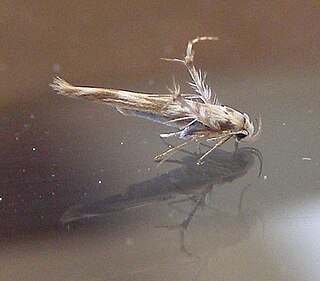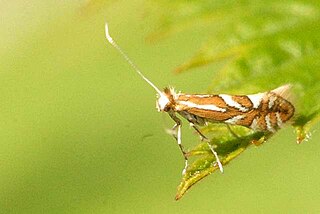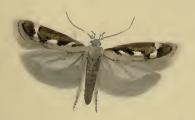
Palumbina is a genus of moths in the family Gelechiidae.

Phyllonorycter oxyacanthae is a moth of the family Gracillariidae. It is found in all of Europe except the Balkan Peninsula.

Caryocolum marmorea is a moth of the family Gelechiidae. It is found from Scandinavia to the Mediterranean islands, and from Ireland to Poland, Hungary and Greece. It is also found on the Canary Islands and Madeira. It is also found in North America.
Hypatima orthostathma is a moth in the family Gelechiidae. It was described by Edward Meyrick in 1921. It is found in Australia, where it has been recorded from Queensland.
Compsolechia halmyra is a moth of the family Gelechiidae. It was described by Edward Meyrick in 1914. It is found in Guyana and Brazil.
Compsolechia antiplaca is a moth of the family Gelechiidae. It was described by Edward Meyrick in 1922. It is found in Peru and Amazonas, Brazil.
Compsolechia loxogramma is a moth of the family Gelechiidae. It was described by Edward Meyrick in 1922. It is found in Amazonas, Brazil.
Aristotelia thalamitis is a moth of the family Gelechiidae. It was described by Edward Meyrick in 1908. It is found in Assam, India.
Palumbina chelophora is a moth of the family Gelechiidae. It was described by Edward Meyrick in 1918. It is found in Assam, India.
Palumbina macrodelta is a moth of the family Gelechiidae. It was first described by Edward Meyrick in 1918. It is found in Assam, India.
Palumbina oxyprora is a moth of the family Gelechiidae. It was described by Edward Meyrick in 1922. It is found in Shanghai, China.
Palumbina tanyrrhina is a moth of the family Gelechiidae. It was described by Edward Meyrick in 1921. It is found on Java in Indonesia.
Thiotricha operaria is a moth of the family Gelechiidae. It was described by Edward Meyrick in 1918. It is found in Assam, India.
Thiotricha grammitis is a moth of the family Gelechiidae. It was described by Edward Meyrick in 1908. It is found in Assam, India.
Antaeotricha corvigera is a moth of the family Depressariidae first described by Edward Meyrick in 1915. It is found in Guyana and Peru.
Epichostis antigama is a moth in the family Xyloryctidae. It was described by Edward Meyrick in 1908. It is found in southern India.
Epichostis dicremna is a moth in the family Xyloryctidae. It was described by Edward Meyrick in 1908. It is found in Sri Lanka.
Epichostis leucorma is a moth in the family Xyloryctidae. It was described by Edward Meyrick in 1908. It is found in Assam, India.
Epichostis tympanias is a moth in the family Xyloryctidae. It was described by Edward Meyrick in 1908. It is found in Assam, India.
Aeolanthes euryatma is a moth in the family Depressariidae. It was described by Edward Meyrick in 1908. It is found in Assam, India.

